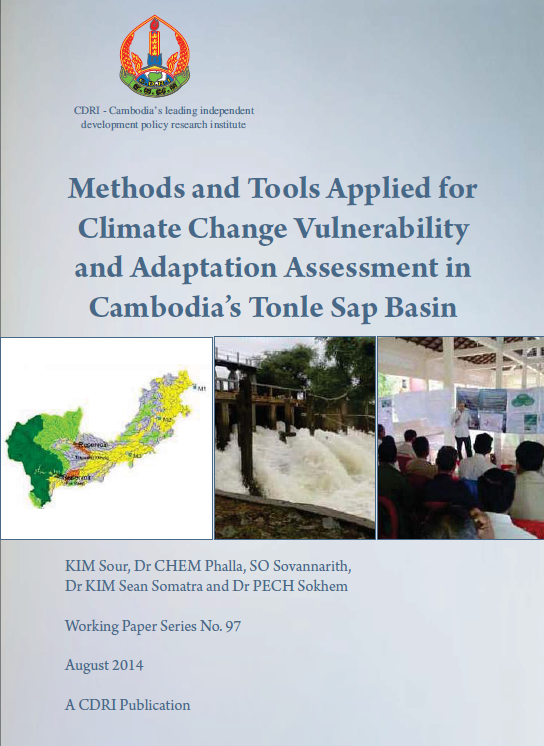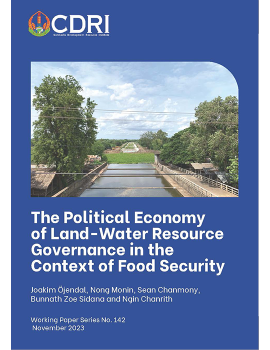
Methods and Tools Applied for Climate Change Vulnerability and Adaptation Assessment in Cambodia’s Tonle Sap Basin
Abstract/Summary
Cambodia is
highly susceptible to natural disasters due to the frequency and intensity of extreme
climatic events, primarily floods, droughts and windstorms, but also in
particular to increased climate variability.These disasters and climate-related
hazardshave exacted huge socioeconomic costs on the country’s economy and
people’s livelihoods, especially in the last decade. It isimportant, therefore,
to understand not only the level of impactbut also the vulnerability and the
capacity of people to adapt to these hazards. This emphasises the needfor vulnerability
and adaptation assessmentsthat are tailored to site-specific local scale.
This paper reviews existing methods and tools used for
understanding the impacts of climate change, the vulnerability and the adaptive
capacity of local people, with a particular focus on water use and governance
in three project target areas in the Tonle Sap Basin, under the project
“Climate Change and Water Governance in Cambodia”. The objectives of this
review are twofold: to understand how different organisations have approached
the evaluation of vulnerability and adaptive capacity in relation to climate
change and water governance; and toanalyse the strengths and gaps in existing
tools and methods based on how they address vulnerability and adaptation as a
function of exposure, sensitivity and adaptive capacity.
The tools and methods that have been applied by various
organisations in different institutional settings and at different geographical
scales and locationscan be broadly grouped under three categories: climate,
hydrologicaland socioeconomic modelling and downscaling; participatory approaches
that engage local communities; and decision support tools to evaluate
alternative adaptation strategies.
To detect trends and understand the implications of climate change
at the local level, the regional climate modelling system Providing REgional
Climates for Impacts Studies (PRECIS) can be used to downscale the outputs of
general circulation models (GCMs) from the national scale (Cambodia) to
catchment (Tonle Sap) scale.Hydrological models, the Soil and Water Assessment
Tool (SWAT) and Integrated Water Quantity and Quality Model (IQQM) have been
applied at the catchment level to generate new understandingabout river basin
and human controls on the spatial and temporal distribution of water flow and
to deepen understanding of supply-demand relationships. Also, ISIS—a software
package that can simulate water flow, hydrology, water quality changes and
sediment transport in rivers, floodplains, lakes, canals and coastal areas—has
been used as a flood forecasting tool in the Tonle Sap Basin.
Participatory tools including climate vulnerability and capacity
analysis (CVCA), communitybased adaptation toolkits and participatory capacity
and vulnerability assessment (PCVA) have been used to assess the impacts of
climate variability and change on local livelihoods, especiallythose of
vulnerable groups. This approach tries to understand how people directly experience
the effects of climate change.
Cost benefit analysis (CBA) and multi-criteria analysis (MCA) are
popularly used as decision support tools for selecting and prioritising
interventions and/or projects as well as relevant policy areas relatedto
climate change.
The review concludes that testing the extent of climate change
vulnerability and adaptive capacity requires an integrated approach combining
comprehensive vulnerability and adaptation assessment frameworks. Whether these
vulnerability assessment frameworks should be applied simultaneously or one at
a time dependson the specific context,data availabilityand resource requirements.
Indicators and indices that measure climate change exposure,
sensitivity and adaptive capacity could be used to produce maps showing the
spatial distribution of these three components of vulnerability. In the Tonle
Sap, the indicators should be used for monitoring the extent of adaptation,
mitigation and vulnerability at the community and local levels.
The selection, application and cost-effective use of appropriate
databases,tools and methods, and the conduct ofcommunity and catchment-level
vulnerability and adaptation assessments will eventually lead to
recommendations for improved and locally-appropriate site- and contextspecific vulnerability
adaptation measures in the Tonle Sap Basin catchments.



